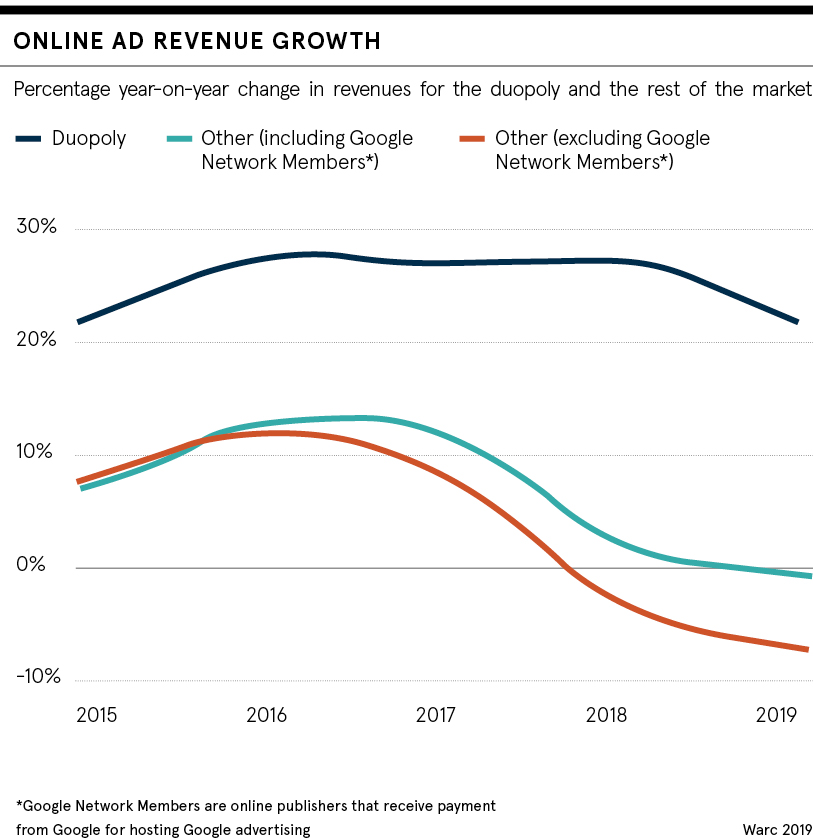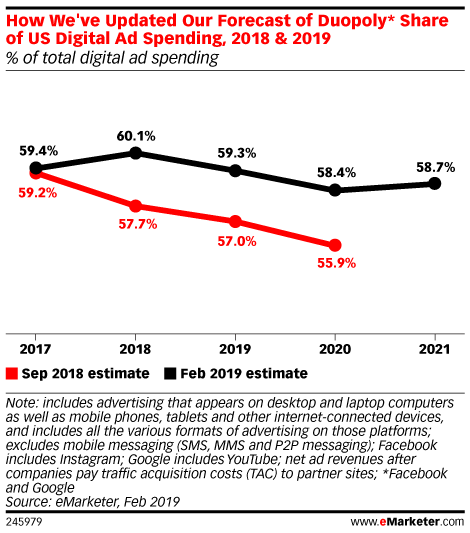Dual Domination of the Online Ad Market
All retailers have the same fundamental problem that they neither fully understand, nor have the ability to solve.
The problem is that in today’s age, digital advertising runs almost exclusively through just two sources: Facebook and Google. This makes customer acquisition extremely expensive, with many businesses seeing little return (if any at all) on their acquisition campaigns – especially when they mostly draw in customers who spend once and never come back again.
We have a simple solution to this growing problem. Instead of seeking to acquire any customer on Facebook and Google, you want to target the right customer.
Forcing Retailers to Pay More
Earlier this year, Google and Facebook’s share of the global online ad market was slated to increase up to 61.4 percent, up from 56.4 percent in 2018. In addition, there was a projected $176.4 billion in ad revenues – signifying a 22 percent spike from the year before. Meanwhile, ad spend outside of the two giants (i.e. the rest of the competition) was slated to drop by 7.2 percent.

It comes as no surprise to learn that for each of the past 10 years, both parties have raised the prices of their clicks. Meanwhile, retailers by and large have been forced to reluctantly go along with these increases, simply because they do not have any other options. As a result, digital advertising has become both increasingly expensive and oversaturated. Looking ahead, many speculate that there is still plenty of room left for growth, with estimates of downturns back in late 2018 proving to be wrong.

In fact, this cycle already happened years ago with Direct Mail, where the cost of postage increased to the point where no one could afford it anymore. A monopoly was in charge then, and eventually some businesses could no longer participate – which is exactly what is happening in the digital realm today.
The Solution: Acquire High Value Customers
The only way to move ahead and succeed in this environment is to actively seek out the customers who spend more, more often than the rest. These are known as Most Valuable Buyers (MVBs), which starkly contrast to those one-and-done buyers who are both expensive to acquire and offer no value in return.
Statistics show that MVBs actually drive 75-80 percent of a company’s profits – despite consisting of only about 15-20 percent of its base as a whole.
For example, if it costs $100 to acquire a customer that only delivers $50 in return, your efforts are not only in vain, they are detrimental to your bottom line.
On the other hand, if a high-value customer brings in $500, they were well worth the effort to secure the first purchase. This is precisely why it is so important for retailers to get the most out of their advertising spend by drawing in (and retaining) these MVBs.
The reason why the top fashion brands pay so much to have storefronts on Park Avenue is due to the greater value of each purchase made there. Statistically, the cost of each transaction made in those storefronts is greater than anywhere else – because of the sense of exclusivity that those premier locations exude – and their ability to bring in higher value customers.
How to Execute
Ultimately, this strategy is all about selecting the right targets and driving them to the trial purchase.
However, in order to justify the cost of acquiring any customer (particularly high-value ones), retailers must possess strong retention capabilities and processes. Specialized software like Predictive Marketing Automation (PMA) platforms will help to heighten the value of each new customer while also working to increase the value of their spending over time.
Fundamentally, marketing is about getting to know your target audience and those within your customer base. Typically, brands implement a one dimensional approach in which they do not have the ability to actually know who their customers are – let alone accurately predict the probability of gaining subsequent purchases.
A PMA’s automation capacities offer an all-encompassing, 360-degree view of consumer behavior, allowing marketers to reach the right customer, at the right time, on the right channel, with the right message.
Conclusion
In this game, it is not about the number of customers you’ve acquired. In reality, whoever has the highest value customers wins. With so many options out there, consumers are generally fickle, and most only purchase once.
Great businesses are built on great customers, and MVBs form the backbone of any successful business. They are the ones who will help drive your business ahead of the competition.
Equipped with the right technological toolset, you will be able to methodically, consistently increase your ability to acquire higher value customers at a rate that takes your business to the next level – free from the reigns of Google and Facebook’s duopoly.





